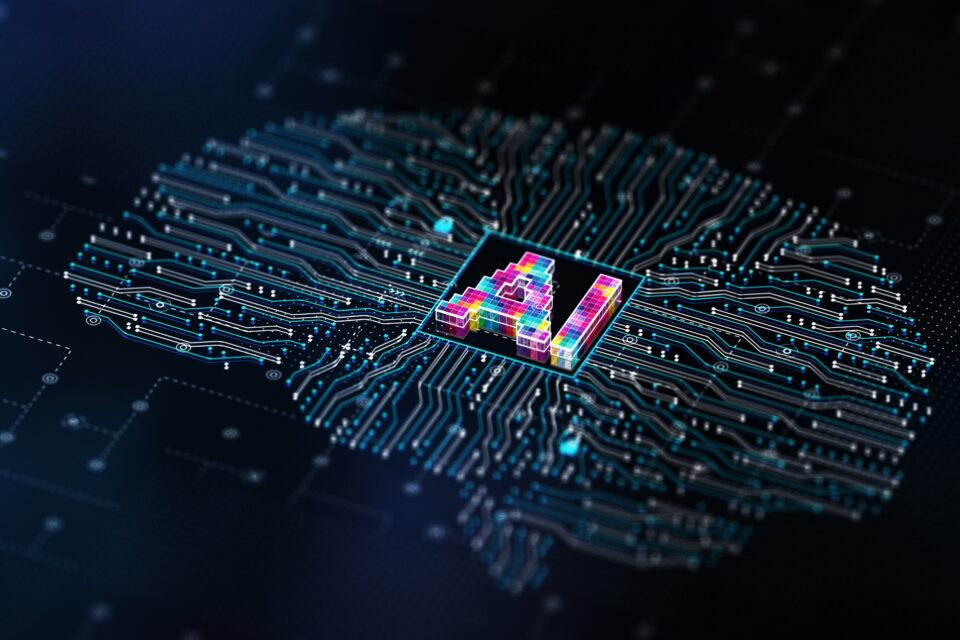When facilitation meets real-time AI collaboration
A New Chapter in Collaboration
As Miro unveils its next chapter in collaborative AI at Canvas 2025, we’re reflecting on a journey that began not with code, but with a question:

In an era when most AI tools promised to make individuals faster, we wondered how AI could make teams better. After years of running facilitation workshops around the world, one truth was clear: most innovation problems aren’t about ideas—they’re about alignment. People don’t struggle to think creatively; they struggle to think together.
That’s the problem we set out to solve. And that’s where this story begins.
The Vision Before the Tools
Back at SXSW 2025, we invited a room full of innovators, facilitators, and technologists to imagine a new kind of collaboration—one where artificial intelligence wasn’t a tool outside the circle but a teammate inside it.
Our session, AI Teammates: Facilitating Human Connection in the AI Era, wasn’t about automation or productivity hacks. It was about relationship. We staged a live experiment: participants interacted with fictional “AI teammates”—each with a personality and role to play in the group dynamic.
- There was The Challenger, who surfaced hard truths.
- The Synthesizer, who connected patterns across ideas.
- The Optimist, who expanded possibility.
- And The Historian, who anchored choices in precedent.
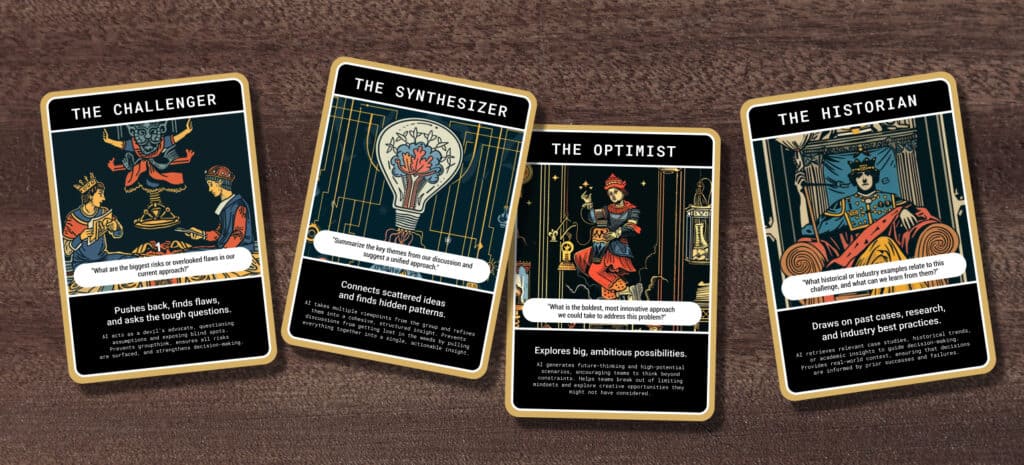
These personas weren’t chatbots. They were conversation archetypes designed to stretch how people think together.
As the session unfolded, something remarkable happened. The room came alive—not because of any output the “AI” produced, but because people started thinking differently about how they thought together.
When the exercise ended, one participant said, “I’ve never seen AI make a conversation feel more human.”
That comment stuck with us. It wasn’t about speed; it was about sensemaking. And yet, at the time, there was no product to make this vision tangible. It was still a simulation—a facilitation experiment about what could be.
The Moment Miro Made It Real
Fast-forward to the summer of 2025. When Miro invited us into the early beta of AI Flows and Sidekicks, we instantly recognized it as the missing bridge between concept and capability.
Here, finally, was the interface we had imagined at SXSW:
AI that could listen, synthesize, and act alongside humans, right inside the collaborative canvas.
We began experimenting in August, building facilitation patterns and testing how Miro’s new AI could support real-time group work. What we discovered was transformative.
AI Flows acted as intelligent pipelines—automating the translation of inputs (research, briefs, notes) into structured, visual outputs like user journeys, prototypes, or summaries.
AI Sidekicks took it a step further. They gave form to something we’d imagined months earlier at SXSW: AI as a teammate, not a tool. With Miro’s Sidekick framework, we could finally bring our original AI Teammate personas—The Challenger, The Synthesizer, The Optimist, The Historian—directly into the canvas as participants that offer voices often missing in the room. Whether surfacing dissent, expanding optimism, or connecting overlooked patterns, these AI teammates help facilitators create richer, more balanced conversations. What had been a facilitation exercise in Austin became an intelligent, inclusive system teams can now use in real sessions.
It was the perfect realization of our SXSW philosophy:

We brought our original AI Teammate personas—The Challenger, Synthesizer, Historian, and Optimist—into Miro as Sidekicks. We even added new ones:
- The Sketcher, who makes structure visible.
- The Co-Facilitator, who guides process and inclusion.
Each Sidekick embodied a mindset we teach in facilitation—listening deeply, synthesizing meaning, and supporting clarity.
For the first time, AI could actively participate in a team’s thinking process rather than merely executing after the fact.
Behind the Scenes: Building the Bridge
Our collaboration with Miro’s product and partner teams felt like a masterclass in co-creation. We shared prototypes, tested facilitation flows, and offered feedback on how facilitators actually use AI in live settings.
Our earliest conversations centered on one key distinction:

That question shaped our approach to every prototype.
We realized that the future of collaboration isn’t about speeding up work—it’s about amplifying shared understanding. AI should help teams see patterns sooner, articulate assumptions faster, and move forward together more confidently.
It’s not automation for automation’s sake. It’s augmentation for alignment.
Instant Prototyping: From Insight to Alignment in Minutes
To prove this approach, we built Instant Prototyping—a Miro AI Flow designed to help teams move from an opportunity to a prototype in minutes.
Instant Prototyping turns messy beginnings into momentum.
You paste your opportunity brief, add any research, and click “Run.” Within moments, the Flow generates:
- Research Insights — a synthesized view connecting what you know.
- User Flow — a map of how someone might engage with your solution.
- Screen Requirements — what each step needs to deliver.
- Prototype — a visual concept you can immediately react to.
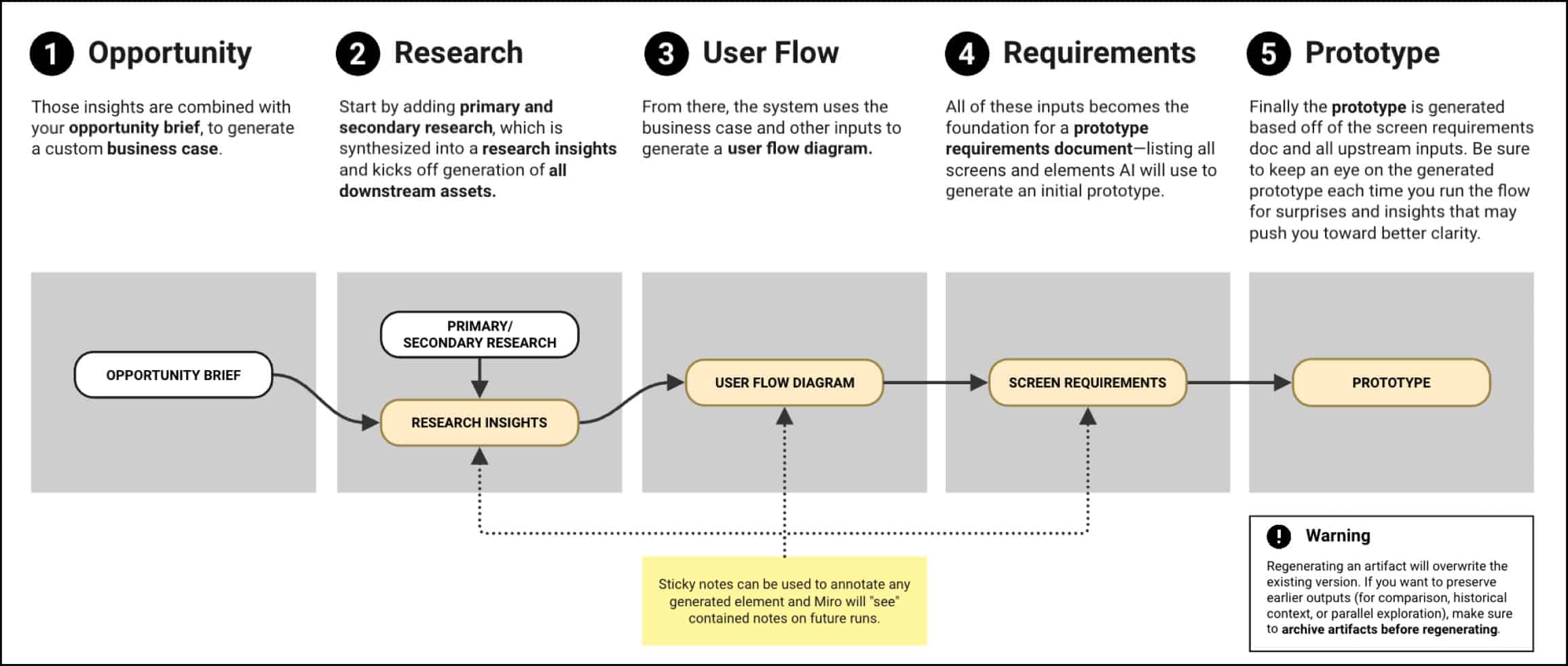
The process feels facilitative: review, adjust, and re-run. Each iteration invites reflection and sharper focus. When the AI gets it wrong, that’s useful—it reveals assumptions, gaps, and preferences faster than traditional review cycles ever could.
“When the AI is wrong, it’s useful—it surfaces gaps and preferences fast, accelerating alignment.”
This pattern—speed plus direction—has become the backbone of how we help teams build clarity in real time.
Proof of Concept: Breakout Buddy
The first major product we built using Instant Prototyping was Breakout Buddy, a revolutionary Zoom facilitation app that gives hosts unprecedented control over breakout sessions.
In just a few weeks, we went from a blank canvas to a working prototype. Using AI Flows, we synthesized user research, mapped facilitator pain points, and visualized solutions—all inside Miro.
Each iteration made the design clearer. By the end of the first session, we weren’t debating what to build—we were deciding how to make it real.*
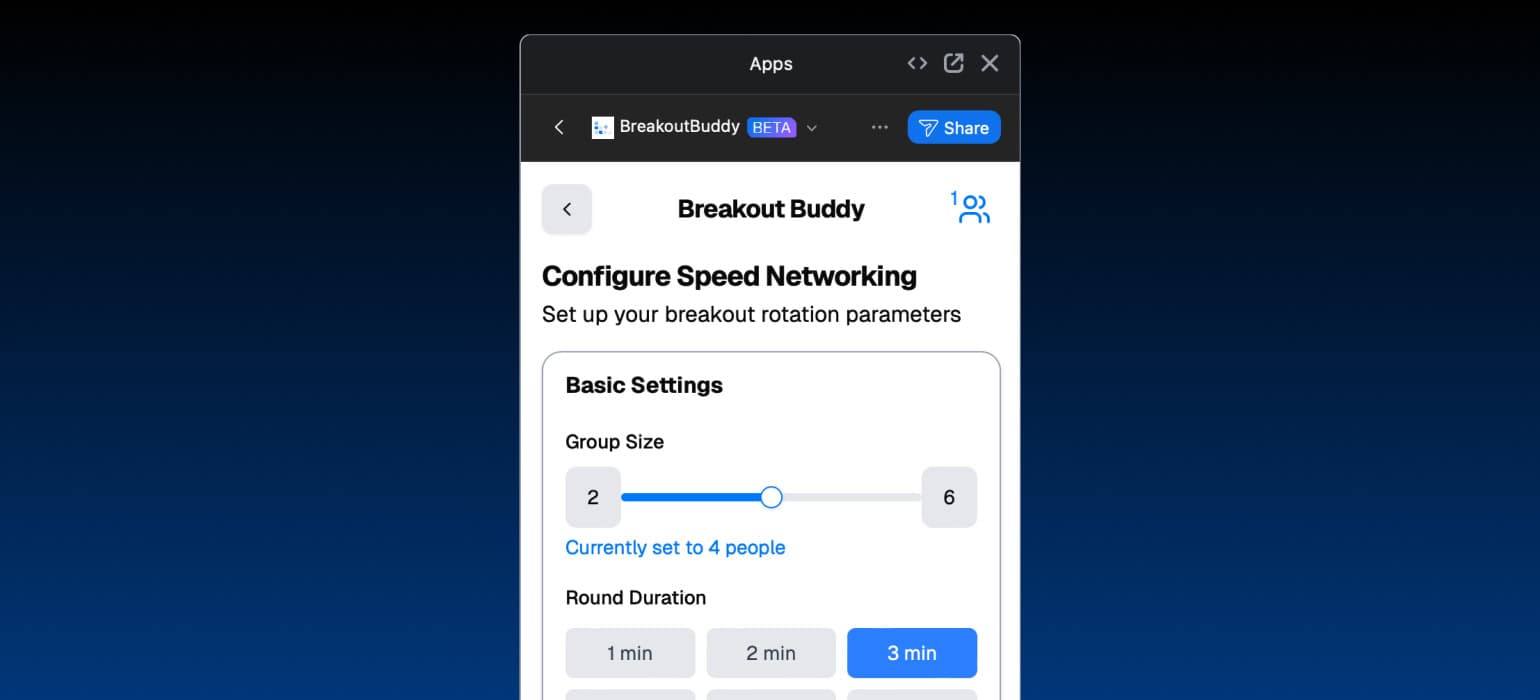
That clarity paid off. Breakout Buddy is now in review at Zoom’s marketplace, a tangible example of how facilitation-guided AI can accelerate both design and decision-making.
Instant Prototyping didn’t just make us faster; it made us truer to our facilitation roots—inviting multiple perspectives, clarifying intent, and turning conversation into shared artifacts.
Field Testing with Real Clients
Following the success of Breakout Buddy, we began testing Instant Prototyping and AI Flows with select clients in diverse industries.
- Financial Futures Planning App: A fintech startup used our Flow to translate complex customer research into clear decision journeys. Within a day, they had multiple prototype directions visualized—something that previously took weeks of back-and-forth between product and design teams.
- Local Home Services Platform: A startup supporting plumbers, electricians, and home service professionals used Instant Prototyping to map their booking experience. The team went from vague strategy discussions to a concrete, visual service flow in a single session.
These pilots validated what we believed all along:

Each engagement reaffirmed that the goal isn’t to replace human thinking—it’s to surface it faster, make it visible, and align around it collaboratively.
AI Teaming: A New Paradigm
At Voltage Control, we call this shift AI Teaming.
It’s the practice of designing relationships between humans and AI systems that are purposeful, participatory, and aligned with facilitation principles.
Most organizations treat AI as a personal productivity tool. But true transformation happens when AI becomes part of the collective intelligence of the group.
Facilitation provides the ethical and practical structure for that shift. It defines:
- How we listen to AI (and each other).
- When to pause automation for reflection.
- How to ensure every voice—including digital ones—is used responsibly.
AI Teaming is not about doing the same things faster. It’s about working differently:
more conscious, inclusive, and experimental.
“Facilitation has always been about helping groups find clarity together. Now AI can help us see that clarity forming in real time.”
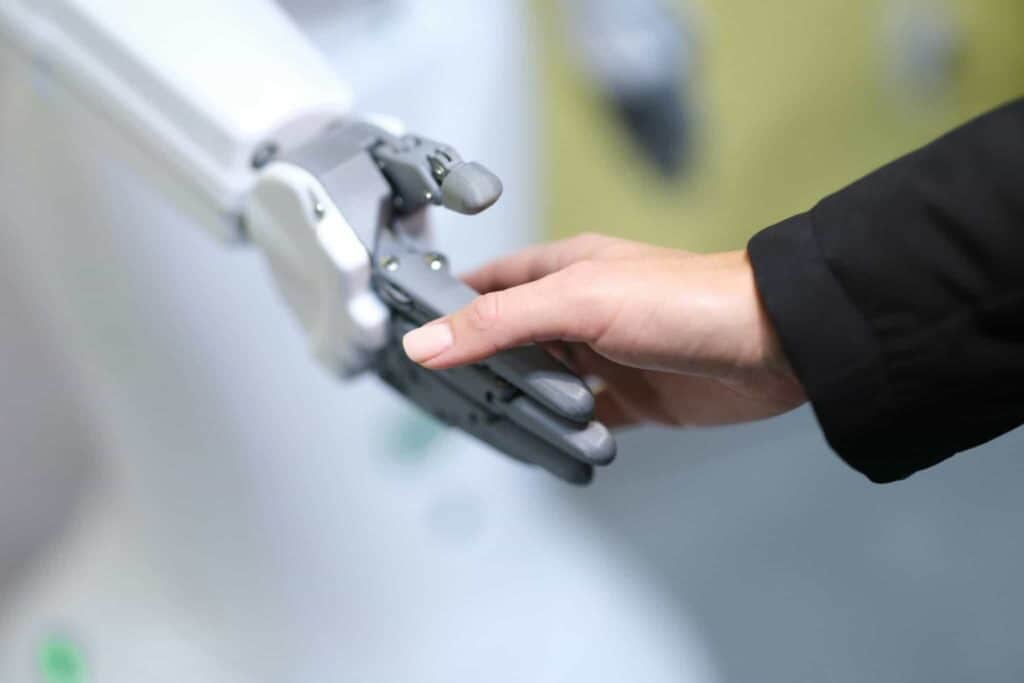
AI Teaming, Not AI Tooling
There’s a quiet but crucial distinction shaping the future of work: AI tooling is about personal productivity. AI teaming is about collective intelligence.
Most organizations still think of AI as something individuals use to move faster — a personal assistant, a summarizer, a generator. Helpful, yes. But when every person uses their own AI tool in isolation, the result isn’t alignment; it’s fragmentation. Ten people might leave a meeting with ten versions of truth.
That’s why facilitation matters.

AI Teaming is built on three principles we’ve practiced for years in facilitation:
- Inclusion: Everyone — human or machine — has a voice, but not every voice should dominate. The facilitator’s role is to balance inputs and create psychological safety for contribution.
- Transparency: The group should always see how conclusions are reached. Hidden algorithms are the enemy of trust. That’s why we design Miro Sidekicks to work in the open — you see every prompt, every output, every change.
- Purpose: AI should never be busywork. It exists to clarify, not to clutter. When used well, AI helps teams focus on why they’re doing something, not just how fast they can do it.
In practice, this means running meetings where AI participates visibly and democratically:
- The Synthesizer summarizes insights, and the group edits or corrects it together.
- The Challenger surfaces risk, and participants discuss trade-offs transparently.
- The Optimist explores new possibilities, and the team refines them collectively.
- The Historian recalls precedent, and the group draws lessons from what’s come before.
- The Sketcher maps structure, and the team spots patterns, gaps, and next steps.
- The Co-Facilitator proposes next moves, and the team stays aligned and engaged.
When AI joins the conversation like this, facilitation becomes the safeguard that keeps collaboration human.
We’ve seen how powerful this is in action. In workshops where we introduced Sidekicks as participants, teams reported higher engagement and greater confidence in their decisions. It’s not just that the AI saved time; it changed the tone of dialogue.
Participants started talking to each other more — not less — because they had a shared reference point to react to. That’s the paradox of AI Teaming: the more intelligence you add, the more human the process becomes.
“The future of collaboration isn’t human versus AI. It’s human with AI — guided by facilitation.”
Miro Transformation: Turning Capability into Culture
Technology adoption often fails because teams layer new tools on top of old habits.
Our Miro Transformation programs exist to prevent that.
We guide organizations through a facilitation-first approach to integrating Miro’s new AI capabilities responsibly.
- Step 1: Assess How Teams Work
We observe how information flows, how decisions are made, and where collaboration breaks down. - Step 2: Introduce AI Intentionally
We co-design flows and Sidekicks that enhance—not replace—human judgment. This means creating ethical automations that preserve context, learning, and inclusivity. - Step 3: Measure Real Value
We focus on results that matter: shorter meetings, higher engagement, faster synthesis, and clearer outcomes.
Transformation in Action
- A global innovation team reduced alignment time by 60% by using Sidekicks like The Synthesizer and The Coach during workshops.
- A leadership group adopted AI Flows for decision documentation, cutting weekly update time in half.
- A product team transformed sprint planning from frustration to flow by running Instant Prototyping to visualize priorities on the spot.
Each story reflects the same truth: facilitation is what makes AI collaboration work—ethically, efficiently, and humanely.
Responsible AI: Designing for Trust and Inclusion
As the world rushes toward automation, facilitation is the counterbalance that keeps technology human.
In our AI Strategy Workshops, we help leaders define what responsible AI looks like in their organizations. Together, we explore questions like:
- How do we make AI reasoning transparent to the team?
- When should a facilitator—not an algorithm—make the call?
- How do we ensure that speed doesn’t silence diversity of thought?
Responsible AI begins with inclusion and ends with trust. It’s not a checkbox—it’s a culture.
By grounding AI use in shared principles, we ensure it supports the behaviors that make teams thrive: curiosity, dialogue, and accountability.
Product × Practice × Purpose
At Voltage Control, our partnership with Miro rests on a simple but powerful equation:

- Product gives teams intelligent scaffolding for synthesis and action.
- Practice ensures those tools are used with intention and care.
- Purpose keeps it all rooted in why we collaborate in the first place: to connect, create, and contribute meaningfully.
This triad—Product × Practice × Purpose—is the DNA of AI Teaming. It’s how we turn new technology into new ways of working.
Facilitator Reflections
When we facilitate, we tune into the subtle shift—the instant confusion gives way to clarity. You can see the spark. You can feel the room align.
Seeing that same shift occur with AI present on the canvas is extraordinary. It’s not about replacing intuition; it’s about scaling it.
Facilitators now have new instruments to play with—flows that structure conversation, Sidekicks that spark reflection, and automations that handle logistics so humans can focus on what matters most: the quality of connection.
That’s the art and science of facilitation in the AI era.
The Full-Circle Moment
From SXSW to Canvas, we’ve witnessed a transformation that began as a thought experiment and matured into a new practice of working together.
Today, every team can experience it firsthand:
- Run a Miro AI Flow to turn insights into prototypes.
- Invite AI Teammates like The Challenger or Synthesizer to expand group thinking.
- Use Utility Sidekicks to manage the board and free up human attention.
This isn’t a simulation anymore. It’s collaboration—amplified.
“AI teaming was once an idea we simulated. Now it’s something every team can do—live, visual, and human with Miro.” —Douglas Ferguson, Founder & CEO, Voltage Control
Join the Movement
Explore how facilitation and AI come together to unlock team potential:
- Explore Voltage Control’s Miro AI Collection
- Join the Instant Prototyping Waitlist
- Discover Miro Transformation Programs
Because the future of collaboration isn’t about replacing people, it’s about inviting AI in to help people work better, together.
